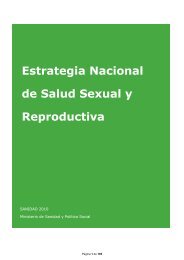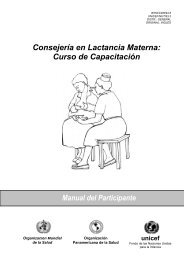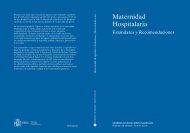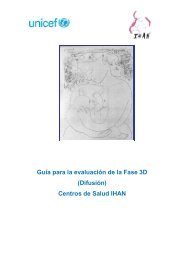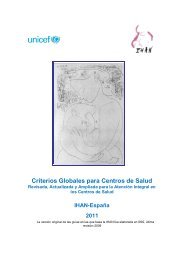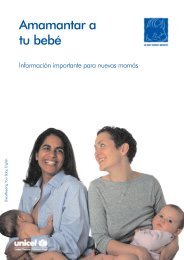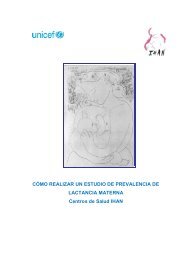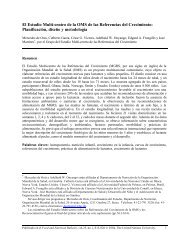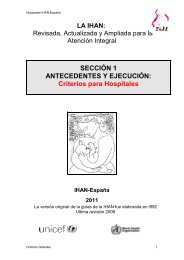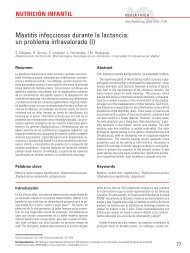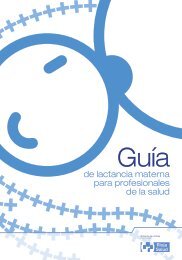La alimentación del lactante y del niño pequeño - libdoc.who.int ...
La alimentación del lactante y del niño pequeño - libdoc.who.int ...
La alimentación del lactante y del niño pequeño - libdoc.who.int ...
Create successful ePaper yourself
Turn your PDF publications into a flip-book with our unique Google optimized e-Paper software.
9. POLÍTICAS, SISTEMA DE SALUD Y ACCIONES COMUNITARIAS<br />
95<br />
Principios de Orientación para la alimentación de<br />
niños no amamantados entre los 6 y 23 meses de edad<br />
(22). En el Anexo 4 se presenta una lista de los indicadores<br />
principales y sus definiciones. Además de la<br />
información sobre cobertura basada en la población,<br />
también son importantes, las evaluaciones periódicas<br />
de la calidad de los establecimientos de salud (23) y las<br />
evaluaciones sobre el progreso hacia los objetivos operacionales<br />
definidos por la Estrategia Mundial, con el<br />
propósito de incrementar la proporción de <strong>lactante</strong>s y<br />
niños pequeños que reciben las <strong>int</strong>ervenciones efectivas<br />
sobre alimentación (24).<br />
Referencias<br />
1. WHO. The Global strategy for infant and young<br />
child feeding. Geneva, World Health Organization,<br />
2002.<br />
2. UNICEF, WHO, WABA et al. Innocenti declaration<br />
on infant and young child feeding. New York,<br />
UNICEF, 2005.<br />
3. WHO, UNICEF. Protecting, promoting and supporting<br />
breastfeeding: the special role of maternity<br />
services. A jo<strong>int</strong> WHO/UNICEF statement. Geneva,<br />
World Health Organization, 1989.<br />
4. WHO. The <strong>int</strong>ernational code of marketing of<br />
breast-milk substitutes. Geneva, World Health<br />
Organization, 1981.<br />
5. ILO. Maternity protection convention No. 183. Geneva,<br />
International <strong>La</strong>bour Organization, 2000.<br />
6. United Nations. Convention on the rights of the<br />
child. New York, United Nations, 1989.<br />
7. WHO. International code of marketing of breastmilk<br />
substitutes: frequently asked questions. Geneva,<br />
World Health Organization, 2006.<br />
8. WHO, UNICEF. Integrated management of childhood<br />
illness: chartbook and training course. Geneva,<br />
World Health Organization, 1995.<br />
9. Santos I et al. Nutrition counseling increases<br />
weight gain among Brazilian children. Journal of<br />
Nutrition, 2001, 131(11):2866–2873.<br />
10. Zaman S, Ashraf RN, Martines J. Training in<br />
complementary feeding counselling of health care<br />
workers and its influence on maternal behaviours<br />
and child growth: a cluster-randomized trial in<br />
<strong>La</strong>hore, Pakistan. Journal of Health, Population<br />
and Nutrition, 2008, 26(2):210–222.<br />
11. WHO, UNICEF, BASICS. Nutrition essentials: a<br />
guide for health managers. Geneva, World Health<br />
Organization, 1999.<br />
12. WHO. Community-based strategies for breastfeeding<br />
promotion and support in developing countries.<br />
Geneva, World Health Organization, 2003.<br />
13. Prochaska JO, DiClemente CC. Transtheoretical<br />
therapy toward a more <strong>int</strong>egrative mo<strong>del</strong> of<br />
change. Psychotherapy: Theory, Research and Practice,<br />
1982, 19(3): 276–287.<br />
14. Bhandari N et al. An educational <strong>int</strong>ervention<br />
to promote appropriate complementary feeding<br />
practices and physical growth in infants and<br />
young children in rural Haryana, India. Journal of<br />
Nutrition, 2004, 134:2342–2348.<br />
15. WHO, UNICEF. Breastfeeding counselling: a training<br />
course. Geneva, World Health Organization,<br />
1993.<br />
16. WHO, UNICEF. Infant and young child feeding<br />
counselling: an <strong>int</strong>egrated course. Geneva, World<br />
Health Organization, 2007.<br />
17. Haider R et al. Effect of community-based peer<br />
counsellors on exclusive breastfeeding practices<br />
in Dhaka, Bangladesh: a randomized controlled<br />
trial. <strong>La</strong>ncet, 2000, 356:1643–1647<br />
18. Haider R et al. Training peer counsellors to promote<br />
and support exclusive breastfeeding in Bangladesh.<br />
Journal of Human <strong>La</strong>ctation, 2002, 18:7–12.<br />
19. de Maza IC et al. Sustainability of a communitybased<br />
mother-to-mother support project in periurban<br />
areas of Guatemala City: <strong>La</strong> Leche League<br />
study. Arlington, Virginia, BASICS, 1997.<br />
20. WHO, IFPRI, UC Davis, FANTA, USAID,<br />
UNICEF. Indicators for assessing infant and young<br />
child feeding practices. Part I. Definitions. Geneva,<br />
World Health Organization, 2008.<br />
21. PAHO/WHO. Guiding Principles for complementary<br />
feeding of the breastfed child. Washington DC,<br />
Pan American Health Organization, 2003.<br />
22. WHO. Guiding Principles for feeding non-breastfed<br />
children 6–23 months of age. Geneva, World Health<br />
Organization, 2005.<br />
23. WHO/UNICEF. Indicators for assessing health<br />
facility practices that affect breastfeeding. Geneva,<br />
World Health Organization, 1993 (WHO/<br />
CDR/93.1, UNICEF/SM/93.1)



